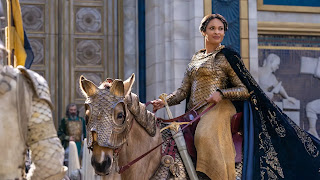Tolkien’s Ace Princess?
 |
| The Rings of Power: Amazon Studios, 2022 |
Like many, I have been enjoying Amazon’s new drama series, The Rings of Power, based on JRR Tolkien’s mythos regarding the Second Age of Middle-Earth, Númenor and the Undying Lands. It’s driven me back to the source texts, to discover from where the creators of the series got their ideas.
One of those source texts is the book of Unfinished Tales. And that’s where I discovered the story of Aldarion and Erendis. It’s an unusual tale for Tolkien, in that it deals with the breakdown of a marriage. And while it provides canonical precedent for the Elves asking the Men of Númenor for help against the growing threat of Sauron’s return, that’s not what I want to talk about.
I want to talk about ace representation.
Many people will find Lord of the Rings and The Hobbit pretty ace anyway. For me, the film trilogy in the 2000s was the beginning of my journey back to my true self. In my head, Legolas is ace. There’s nothing I know of in Tolkien to either confirm or deny that.
But now I’ve discovered Ancalimë, the first Ruling Queen of Númenor.
In the Unfinished Tale, Erendis falls in love with Aldarion, heir to the throne of Númenor. He’s kind of in love with her too, but he’s also in love with the sea. He just can’t help going off on long voyages to Middle-Earth. (We later learn that he’s been of great help to the Elven king Gil-Galad against the rising of evil there, but he doesn’t bother telling his family that).
After a very long, on-and-off courtship, Aldarion and Erendis marry. But he can’t stay away from the sea. In the end, they become estranged and separate. By now, they have a daughter, Ancalimë, who Erendis brings up in her strictly all-female household. We get a lot of Erendis’ point of view in this story, and it’s a surprisingly feminist viewpoint.
Men in Númenor are…children in mind until age finds them - and then many only forsake play out of doors for play in their houses…. All things are made for their service: hills are for quarries, rivers to furnish water or to turn wheels, trees for boards, women for their body’s needs, or if fair to adorn their table and hearth; and children to be teased when there is nothing else to do - but they would as soon play with their hounds’ whelps.
Brought up in this way, Ancalimë becomes a pawn in her parents’ arguments, and grows to harbour a certain resentment against both of them. As her father’s only child, she is heir to the throne, and relishes that power.
Like her mother, she prefers to be surrounded by women. But we are also told that she “did not desire love, nor did she wish for a son.” She is eventually forced to marry her kinsman Hallacar. But she tells him that if she could wed who she wanted, “that would be Úner (which is “Noman”), whom I prefer above all others.” We are told, “Her life with Hallacar was unhappy, and she begrudged him her son Anárion, and there was strife between them thereafter.” Hallacar publicly mocks her by inviting her to a fake wedding party and announcing, “The weddings are prepared, and the bride-chambers ready. But since it cannot be thought that we should ask the Lady Ancalimë, King’s Heir, to lie with a farm steward (himself), then, alas! she must sleep alone tonight.” At which everyone laughs at her.
Ace representation? What do you think? It doesn’t paint a very positive picture of asexual identity. But given the “invisible” nature of asexuality, ace characters in literature are often only identifiable through their negative reactions and experiences.
What’s truly remarkable about Ancalimë’s story is the resemblance it bears to an as-yet-unpublished Arthurian novel I have been writing. Estranged parents; the mother setting up an all-female household; an asexual daughter. And I hadn’t even read “Aldarion and Erendis” before!
I sometimes joke that, as Tolkien died in 1973 and I was born in 1973, I am his replacement.
Perhaps I am!



Comments
Post a Comment